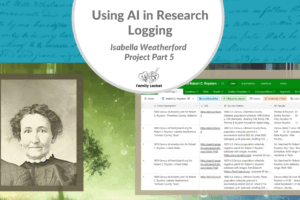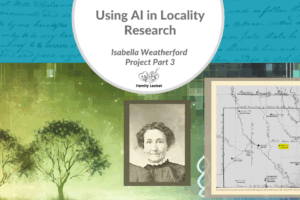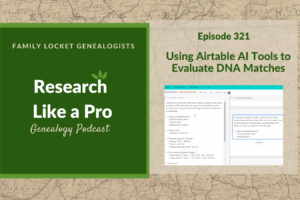After my first day uncovering over twenty Harris family records, I returned to the Love County Clerk’s office with curiosity about what other records might exist, particularly from the county’s earliest years. I didn’t have a specific research plan beyond exploring the oldest volumes to see what I might find. Day two would prove interesting in unexpected ways—sometimes courthouse research yields valuable discoveries not because you know exactly what you’re looking for, but because you stumble upon records that provide broader historical context for your ancestors’ world.
This is the fifth post in our onsite research series. Read the other posts here:
Onsite Research: Beyond Digitized Records: explains the onsite research series
How to Prepare for an Onsite Genealogy Research Trip: explains the kinship determination project and research objective
Treasure Hunt at the Love County Courthouse: Uncovering Land Records: describes the morning’s successful deed research
Love County Tax Records: Research Adventures in an Old Jail: covers the first afternoon’s tax record discoveries
Cemetery Research: Connecting with the Final Resting Places
My second day began with visiting the Burneyville Cemetery, where John C. Harris was buried, and documenting members of the Frazier family—relatives of Dock Harris’s wife, Allie—who were also buried there. I found the graves of Allie’s parents – Nancy E. (Briscoe) Frazier and Richard Frazier.
I then drove to Leon Cemetery where Arza Harris (John C.’s third wife) was buried along with two of her children, before taking time to drive around the actual land parcels I had identified in the previous day’s deed research.
Early Deeds: The Foundation Records
After my tax findings the day before, I knew John C. Harris owned land in the town of Marietta, also known as Marietta City in the tax records. I hadn’t found any deeds for that land yet, but I knew he was taxed for it in 1908, so I looked for early deed indexes. On the first day of my research, I had used indexes that all started in 1914. I wondered where the index books were for the period between 1907 and 1914. After poking around at some of the volumes turned without their spines pointing out, I found an index for earlier years.
This deed index contained the earliest recorded deeds from the county’s formation in 1907 and the immediate years following for Township 7 South, Range 2 East, the area that includes Marietta City. Paging through the index, I came across a deed dated January 31, 1908, in volume 1 that immediately caught my attention because of the grantee’s name: R.E. Frazier. Given that I had just visited the Burneyville Cemetery where my ancestor Richard Frazier was buried, I was excited to potentially find a connection.
Deed book 1 had handwritten instead of typed deeds that had been copied and rebound into a new book (as all the deed books had been recently rebound into red hardcover sturdy books). Book 1 contained the foundational land transactions that established the county’s property ownership patterns.
The Sophie Williams – R.E. Frazier Deed
The 1908 deed Williams-Frazier deed revealed fascinating details about the complex land transactions occurring during this transition period:[1]
Grantor: Sophie Williams (née Sophie Bobb), identified as a “mix-blood Choctaw Indian woman over 18” Co-grantor: Jonas Williams
Grantee: R.E. Frazier of El Dorado, Kansas
Consideration: $200
Property: South Half (1/2) of the Southwest (1/4) of the Southwest one-fourth (1/4) of the Northwest one-fourth (1/4) of the Northwest one-fourth (1/4) of Section 21, Township 7 South, Range 2 East, located in Love County, Oklahoma
The deed specifically stated it was for “inherited lands, representing one-fourth of Sophie Williams’s surplus filings,” providing insight into how tribal members were disposing of lands they had received beyond their primary allotments.
I was struck by the historical significance of what I was viewing. These were the very first official property transactions recorded after Oklahoma statehood, documenting the transition from Indian Territory’s complex tribal land systems to the standard American property law framework.
Historical Context -Indian Territory Land Allotments
I gave Claude AI the task to use its Research capabilities and write a report based on web sources about the land allotments during the transition from Indian Territory to Oklahoma statehood. The following paragraph is a summary of the longer report:[2]
“The transition from Indian Territory to Oklahoma statehood between 1900-1910 fundamentally transformed over 6.3 million acres of Chickasaw Nation territory through federal allotment policies administered by the Dawes Commission.[3] Under the Curtis Act of 1898 and the 1902 Choctaw-Chickasaw Supplemental Agreement, each Chickasaw citizen received 320 acres of allotted land, with each designating a homestead of up to 160 acres that remained inalienable during their lifetime.[4] Beyond these homestead designations, tribal members could dispose of their “surplus” allotted lands through a systematic alienation schedule: one-fourth could be sold after one year, another fourth after three years, and the remaining half after five years from patent issuance.[5] This surplus land disposal process generated the complex web of certificates of purchase, federal patents, and tribal nation conveyances that appear in courthouse records, as tribal members like Sophie Williams sold their surplus filings to non-Indian purchasers through competitive bidding systems administered by the Commissioner to the Five Civilized Tribes.[6] The entire process created over 250,000 enrollment applications, final rolls for 101,000 approved tribal members, and a hybrid legal framework where federal trust law intersected with emerging state property regulations after Oklahoma statehood in 1907.[7]”
Following the Paper Trail: A Case of Mistaken Identity
Initially excited about this potential family connection, I continued searching for additional records involving this R.E. Frazier. I found Sophie Williams had executed a lease to R.E. Frazier for additional land in sections 20 and 29 in Township 7 South, Range 2 East on the same day, 31 January 1908, suggesting he was actively acquiring property in the area.[8]
Following R.E. Frazier’s ownership chronologically, I discovered he held onto these lands until 21 February 1912, when—now identified as being “of Butler County, Kansas”—he sold the consolidated properties in sections 20, 21, and 29 to Rupert P. Bowles.[9]
A major clue about R.E. Frazier’s identity was that his 1912 deed did not include a wife as a co-grantor. Most other deeds included the spouse, if there was one. My ancestor, Richard E. Frazier, was married to Nancy E. Briscoe Frazier and resided in Burneyville until his death in 1911.[10] Nancy survived him and died in 1924.[11]
As I analyzed these records more carefully, it became clear that R.E. Frazier in the deeds of 1908 and 1912 was not the same Richard E. Frazier buried in Burneyville Cemetery. The geographic references (El Dorado, Kansas, and later Butler County, Kansas), the timing, no spouse, and other contextual clues indicated this was a different person entirely—a reminder that common names can lead researchers astray without careful analysis of all available evidence.
While initially disappointing, this discovery provided valuable insight into the broader patterns of land speculation and investment occurring during Oklahoma’s early statehood period, with investors from Kansas and other states actively acquiring and trading Indian Territory surplus lands.
Understanding Index Organization: The Evolution of Record-Keeping
My next focus involved understanding how Love County’s indexing system had evolved during its early years. I located an index titled “6-7-8 South 1-2-3 West – Book 1,” which covered the period from the beginning of the county until November 1913.
This early comprehensive index revealed important information about the county’s administrative development. After November 1913, the indexes were reorganized and split into more specific geographic divisions:
- 6-7-8 South, 1 West: Book 1 of 4 books
- 6-7-8 South, 2 West: Book 1 of 4 books
- 6-7 South, 3 West: Book 1 of 3 books
This reorganization reflected the county’s growth and the increasing volume of land transactions requiring more detailed indexing systems. Understanding these organizational changes is crucial for researchers, as it affects search strategies and ensures comprehensive coverage of available records.
Additional Family Discoveries: The Rice Mortgage Release
While working through this early index, I found several additional records that provided context for my Harris family research. One particularly interesting discovery was a mortgage release in Miscellaneous Book 5, dated March 2, 1909, involving J.D. and S.A. Rice and John C. Harris.
This document revealed that John C. Harris had previously loaned $250 to J.D. and S.A. Rice, secured by lots 1 and 2 in block 4 in the town of Marietta. The mortgage release confirmed that the Rices had fully satisfied their debt, and John C. Harris was releasing his claim on their Marietta property. I originally misunderstood this record and even wrote about it incorrectly in my Kinship Determination Project. I scanned the mortgage and assumed that because it for lots 1 and 2, it was the same property he was taxed on in 1908 and forward. However—reading it now, I realize it was for lots 1 and 2 of block 4, while the other property was lots 1 and 2 of block 63. The courthouse has a map of Marietta City in the hall, which I took a picture of before even knowing its significance to my research. This map shows that block 63 and block 4 are adjacent to each other, so lots 1 and 2 of these blocks are also adjacent.
I also incorrectly assumed that John C. Harris was paying of his mortgage in this mortgage release. However, it was the other way around. J.D. and S.A. Rice paid off their mortgage to John C. Harris. Perhaps he loaned them the money because he was their neighbor; or perhaps he sold them the land. I couldn’t find a deed for this land from John C. Harris to J.D. Rice, so more research will be needed.
This discovery was significant for several reasons. It demonstrated that John C. Harris was financially stable enough to make substantial loans to other community members, providing insight into his economic status during his early years in Love County. The transaction revealed business relationships within the local community, showing how residents supported each other’s property acquisitions through private financing arrangements. Hopefully I can eventually find the original deed for the land in block 4 to understand whether the Rice’s purchased it from John C. Harris or asked him for a private loan.
Exploring Town Patent Books: Windows into Early Community Development
One of the most intriguing discoveries of the afternoon was a set of volumes labeled “Town Patent Books.” These older volumes looked particularly interesting but presented an immediate challenge—they had no apparent index system, requiring page-by-page examination to identify relevant records.
Despite the time-intensive nature of this search method, I decided to systematically page through these volumes looking for any names connected to my family research. The effort proved worthwhile, yielding several interesting discoveries that illuminated the broader community context of my ancestors’ lives. Many towns were included: Burneyville, Orr, Leon, and more.
The John O. Briscoe Town Patent
One discovery that caught my attention was a 1904 patent for John O. Briscoe, who might have been related to Nancy E. Briscoe, the mother of Dock Harris’s wife, Allie. The patent document revealed:
Grantors: Choctaw and Chickasaw Nations
Grantee: John O. Briscoe
Property: Lots 1 and 2 in Block 91 of the town of Orr, Chickasaw Nation, Indian Territory
Payment: $5.13
Significance: This deed officially transferred the Nations’ rights to Briscoe and was recorded in Marietta, Indian Territory
While I couldn’t definitively establish the family connection between John O. Briscoe and Nancy E. Briscoe without additional research, this discovery illustrated the type of small-town property transactions that were creating the foundation for community development during the territorial period.
Claude AI’s summary of its deep research on this topic said:
“The Dawes Commission systematically surveyed and platted 308 townsites across Five Civilized Tribes territories, with town lots auctioned to the public through detailed processes that generated extensive patent records found in modern courthouse research.[12] Communities with populations exceeding 200 were surveyed and platted under Congressional acts of 1900 and 1902, while smaller towns could have up to 40 acres set aside for municipal purposes.[13] Federal appraisal boards—comprising a federal appointee, tribal appointee, and occupant appointee—determined improvement values for existing occupants who received compensation from townsite sale proceeds.[14] The Choctaw and Chickasaw Nations retained significant involvement in these processes despite losing governmental sovereignty under the Curtis Act, participating in patent execution for town lots and maintaining revenue distribution systems for tribal members.[15] These town patents, which granted individual ownership of lots within established municipalities, appear frequently in courthouse records alongside the certificates of purchase and final conveyances that documented the two-step process of federal oversight followed by tribal nation completion of property transfers.[16]
Church Property: The Deacons of the Church of Christ of Leon
Another fascinating discovery was a town patent granted to the Deacons of the Church of Christ of Leon. This finding was particularly meaningful because I knew from my previous research that the Harris family belonged to the Church of Christ, though I wasn’t certain whether they attended services in Leon, Marietta, or both communities.
The church patent provided insight into how religious communities were establishing their institutional presence during the territorial transition period. It also reinforced the importance of Leon as a community center for the Harris family network—John C. Harris had business connections there, Arza Harris lived there, and now I had evidence of the family’s likely church community being formally established with property ownership.
This discovery reminded me that genealogical research benefits from understanding the full institutional and community context of our ancestors’ lives, not just their individual property transactions and family relationships.
Takeaways
This afternoon’s research reinforced several important principles for courthouse research:
- Start with the earliest deed books to understand foundational property transactions from county formation
- Verify similar names carefully using geographic and chronological context – common names can lead to mistaken connections
- Ask courthouse staff about unindexed materials like town patent books that may contain unique community records
- Document how indexing systems evolved over time to ensure comprehensive searching across different organizational periods
- Allow time for both systematic searching and exploratory browsing through older volumes
- Photograph volume covers and organization systems to understand complete archival context
- Record negative results when searching unindexed materials to avoid duplicating efforts
The second day’s research proved that patience and systematic exploration of early records can yield unexpected treasures, even when initial discoveries don’t lead where I expected them to. In my next post, I’ll continue with the tax record discoveries from later in the afternoon of day 2.
AI Disclosure
AI helped write introductory paragraphs and section transitions, while I provided all the specific research details and discoveries.
Sources
[1] Love County, Oklahoma, Deeds 1:158, Sophie Williams to R.E. Frazier, 31 January 1908; Love County Clerk’s Office, Marietta.
[2] “Indian Territory to Oklahoma Statehood: Land Allotment and the Transformation of Property Law, 1900-1910,” Claude Sonnet 4 with Research, user Nicole Dyer, 8 September 2025, Anthropic (https://claude.ai/public/artifacts/83777835-9f38-4204-a470-6da77118751a).
[3] Oklahoma Historical Society, “Allotment,” The Encyclopedia of Oklahoma History and Culture, https://www.okhistory.org/publications/enc/entry?entry=AL011 : accessed 08 September 2025).
[4] Oklahoma State University, “Agreement with the Choctaw and Chickasaw, 1902,” Digital Treaties Collection (https://treaties.okstate.edu/treaties/agreement-with-the-choctaw-and-chickasaw-1902-22427 : accessed 08 September 2025).
[5] Oklahoma Historical Society, “Dawes Commission,” The Encyclopedia of Oklahoma History and Culture (https://www.okhistory.org/publications/enc/entry?entry=DA018 : accessed 08 September 2025).
[6] National Archives, “Dawes Records of the Five Civilized Tribes,” (https://www.archives.gov/research/native-americans/dawes : accessed 08 September 2025).
[7] National Archives, “Commission to the Five Civilized Tribes (The Dawes Commission), 1893-1914,” https://www.archives.gov/files/research/native-americans/dawes/ : accessed 08 September 2025).
[8] Love County, Oklahoma, Miscellaneous Records 1:111, Sophie Williams to R.E. Frazier, lease, 31 January 1908; Love County Clerk’s Office, Marietta.
[9] Love County, Oklahoma, Deeds 6:301, R.E. Frazier to Rupert P. Bowles, 21 February 1912; Love County Clerk’s Office, Marietta.
[10] Find a Grave, database with images (https://www.findagrave.com/memorial/14296957 : accessed 8 September 2025), memorial 14296957, Richard Frazier (1840–1911), Burneyville Cemetery, Burneyville, Love County, Oklahoma; gravestone photo by Sharon Rhoades.
[11] Find a Grave, database with images (https://www.findagrave.com/memorial/14139934 : accessed 8 September 2025), memorial 14139934, Nancy E Frazier (1847–1924), Burneyville Cemetery, Burneyville, Love County, Oklahoma; gravestone photo by Melanie.
[12] Oklahoma Historical Society, “Dawes Commission,” The Encyclopedia of Oklahoma History and Culture, (https://www.okhistory.org/publications/enc/entry?entry=DA018 : accessed 08 September 2025).
[13] Oklahoma State University, “Agreement with the Choctaw and Chickasaw, 1902,” Digital Treaties Collection, (https://treaties.okstate.edu/treaties/agreement-with-the-choctaw-and-chickasaw-1902-22427 : accessed 08 September 2025).
[14] National Archives, “Dawes Records of the Five Civilized Tribes,” (https://www.archives.gov/research/native-americans/dawes: accessed 08 September 2025).
[15] Oklahoma Historical Society, “Curtis Act (1898),” The Encyclopedia of Oklahoma History and Culture, (https://www.okhistory.org/publications/enc/entry.php?entry=CU006 : accessed 08 September 2025).
[16] FamilySearch, “Love County, Oklahoma Genealogy,” (https://www.familysearch.org/en/wiki/Love_County,_Oklahoma_Genealogy : accessed 08 September 2025).





























Leave a Reply
Thanks for the note!